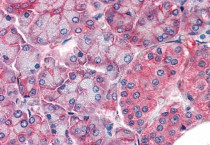ARG63612
anti-CLDN14 / Claudin 14 antibody
anti-CLDN14 / Claudin 14 antibody for IHC-Formalin-fixed paraffin-embedded sections,Western blot and Human
Neuroscience antibody; Signaling Transduction antibody

1
Overview
| Product Description | Goat Polyclonal antibody recognizes CLDN14 / Claudin 14 |
|---|---|
| Tested Reactivity | Hu |
| Predict Reactivity | Ms, Rat, Cow, Dog, Pig |
| Tested Application | IHC-P, WB |
| Specificity | Reported variants represent identical protein (NP_036262.1; NP_652763.1; NP_001139551.1; NP_001139550.1 and NP_001139549.1). |
| Host | Goat |
| Clonality | Polyclonal |
| Isotype | IgG |
| Target Name | CLDN14 / Claudin 14 |
| Antigen Species | Human |
| Immunogen | C-SATHSGYRLNDYV |
| Conjugation | Un-conjugated |
| Alternate Names | DFNB29; Claudin-14 |
Application Instructions
| Application Suggestion |
|
||||||
|---|---|---|---|---|---|---|---|
| Application Note | WB: Recommend incubate at RT for 1h. IHC-P: Antigen Retrieval: Steam tissue section in Citrate buffer (pH 6.0). * The dilutions indicate recommended starting dilutions and the optimal dilutions or concentrations should be determined by the scientist. |
Properties
| Form | Liquid |
|---|---|
| Purification | Purified from goat serum by antigen affinity chromatography. |
| Buffer | Tris saline (pH 7.3), 0.02% Sodium azide and 0.5% BSA. |
| Preservative | 0.02% Sodium azide |
| Stabilizer | 0.5% BSA |
| Concentration | 0.5 mg/ml |
| Storage Instruction | For continuous use, store undiluted antibody at 2-8°C for up to a week. For long-term storage, aliquot and store at -20°C or below. Storage in frost free freezers is not recommended. Avoid repeated freeze/thaw cycles. Suggest spin the vial prior to opening. The antibody solution should be gently mixed before use. |
| Note | For laboratory research only, not for drug, diagnostic or other use. |
Bioinformation
| Database Links | |
|---|---|
| Background | Tight junctions represent one mode of cell-to-cell adhesion in epithelial or endothelial cell sheets, forming continuous seals around cells and serving as a physical barrier to prevent solutes and water from passing freely through the paracellular space. These junctions are comprised of sets of continuous networking strands in the outwardly facing cytoplasmic leaflet, with complementary grooves in the inwardly facing extracytoplasmic leaflet. The protein encoded by this gene, a member of the claudin family, is an integral membrane protein and a component of tight junction strands. The encoded protein also binds specifically to the WW domain of Yes-associated protein. Defects in this gene are the cause of an autosomal recessive form of nonsyndromic sensorineural deafness. It is also reported that four synonymous variants in this gene are associated with kidney stones and reduced bone mineral density. Several transcript variants encoding the same protein have been found for this gene. [provided by RefSeq, Jun 2010] |
| Research Area | Neuroscience antibody; Signaling Transduction antibody |
| Calculated MW | 26 kDa |
Images (2) Click the Picture to Zoom In
-
ARG63612 anti-CLDN14 / Claudin 14 antibody WB image
Western blot: Human liver lysate (35 µg protein in RIPA buffer) stained with ARG63612 anti-CLDN14 / Claudin 14 antibody at 0.3 µg/ml dilution.
-
ARG63612 anti-CLDN14 / Claudin 14 antibody IHC-P image
Immunohistochemistry: Paraffin-embedded Human pancreas tissue. Antigen Retrieval: Steam tissue section in Citrate buffer (pH 6.0). The tissue section was stained with ARG63612 anti-CLDN14 / Claudin 14 antibody at 5 µg/ml dilution followed by AP-staining.









